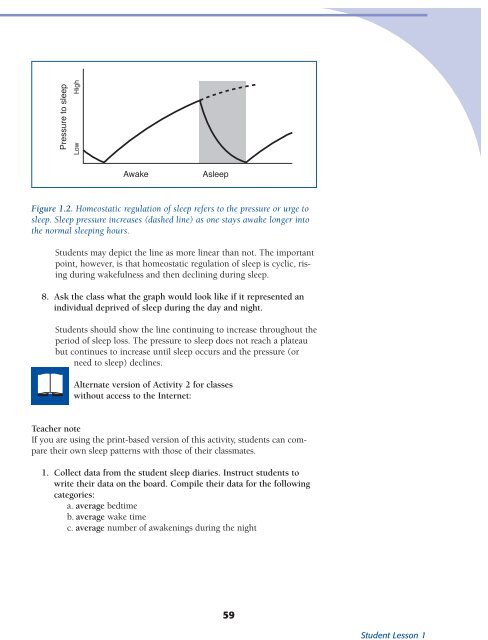Biological - NIH Office of Science Education - National Institutes of ...
Biological - NIH Office of Science Education - National Institutes of ...
Biological - NIH Office of Science Education - National Institutes of ...
You also want an ePaper? Increase the reach of your titles
YUMPU automatically turns print PDFs into web optimized ePapers that Google loves.
Figure 1.2. Homeostatic regulation <strong>of</strong> sleep refers to the pressure or urge to<br />
sleep. Sleep pressure increases (dashed line) as one stays awake longer into<br />
the normal sleeping hours.<br />
Students may depict the line as more linear than not. The important<br />
point, however, is that homeostatic regulation <strong>of</strong> sleep is cyclic, rising<br />
during wakefulness and then declining during sleep.<br />
8. Ask the class what the graph would look like if it represented an<br />
individual deprived <strong>of</strong> sleep during the day and night.<br />
Students should show the line continuing to increase throughout the<br />
period <strong>of</strong> sleep loss. The pressure to sleep does not reach a plateau<br />
but continues to increase until sleep occurs and the pressure (or<br />
need to sleep) declines.<br />
Alternate version <strong>of</strong> Activity 2 for classes<br />
without access to the Internet:<br />
Teacher note<br />
If you are using the print-based version <strong>of</strong> this activity, students can compare<br />
their own sleep patterns with those <strong>of</strong> their classmates.<br />
1. Collect data from the student sleep diaries. Instruct students to<br />
write their data on the board. Compile their data for the following<br />
categories:<br />
a. average bedtime<br />
b. average wake time<br />
c. average number <strong>of</strong> awakenings during the night<br />
59<br />
Student Lesson 1

















